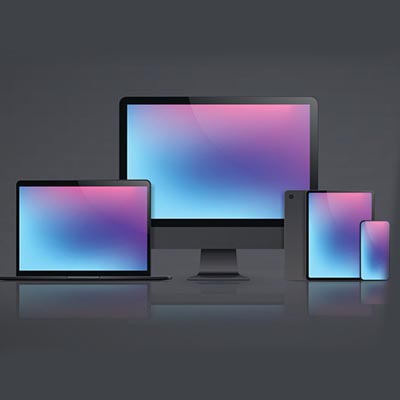
Your desktop needs a monitor or a screen to plug into it, so let’s discuss some of the options and considerations you should keep in mind when purchasing a new display. Chief among these are how many monitors you’ll need, the graphics type, and the specs associated with each of the monitors.
How Many Monitors Do You Need?
Many users won’t think twice about having just one monitor in their home office, but what about at work? You can get so much more done with more monitors, as you will be able to move between tasks easier and more efficiently. We highly recommend going this route, as you can get more done without sifting through an endless number of windows. Many desktops support dual monitor support from the get-go. However, you’ll need to check to see if your new desktop comes with two or more ports for monitors. Here are some examples of ports for your monitors:
- VGA/DVI: These older connections with big plugs and little pins need to be tightened and connected with screws. Older monitors will have these outputs, but you can buy adapters for them so they can plug into newer ports. Even budget desktops still have at least one VGA port, but it’s inevitable that they will eventually disappear.
- HDMI: HDMI is standard these days. It’s the cable that you likely use on the back of your flat-screen television. Modern game consoles and Blu-Ray players use them as well.
- DisplayPort: DisplayPort is similar to HDMI in that it can carry both video and audio. DisplayPort is gradually becoming the standard, and on the technical side, there are some differences between these two, but you should be able to go with either of them.
If you’re on a budget, we recommend making sure that you have enough ports on your computer to ensure you have enough connections for your monitors. For example, if your desktop only has DisplayPort or HDMI, and you only have VGA connectors, you will need to find a way to connect them.
Integrated Video vs Dedicated Graphics
These terms will undoubtedly come up while you’re looking for monitors. Basically, integrated video means that the computer processes video and graphics from hardware that is already built into the motherboard, whereas dedicated graphics means that your computer has a dedicated device built into it to render video. Simply put, most office PCs won’t need dedicated graphics, and to fair, opting out of these expensive graphics cards can save your organization a considerable amount of capital.
Most graphics card chipsets have multiple models, and some even get produced by multiple companies with several brands to sell their own brand of hardware. Since purchasing a graphics card can be just as complex as purchasing the rest of your desktop, it’s probably in your best interest to work with an expert to determine your needs.
Thankfully, if you’re not too concerned about gaming, 3D rendering, video editing, and so on, you can just use the built-in hardware for your desktop.
Purchasing Monitors for Your Desktop
There are countless options out there for computer displays, but you should consider the following specifications when you’re making your decisions.
- Resolution: This is the number of pixels your monitor will display. Over the past decade, this has been standardized to the 16:9 aspect ratio, or widescreen. There are other ultra-wide monitors that break this rule, but most of the time, your monitor will probably be either HD, FULL HD, Ultra HD, or 4K. But what do these even mean?
- HD: Believe it or not, HD is the low end of this spectrum. This resolution tends to look best on small screens with a resolution of 720p. It’s typically seen on budget laptops.
- FHD: FHD is known as 1080p, and it’s the most common resolution. You should aim for at least this.
- UHD: Ultra HD has a resolution of 3840×2160. It may not be supported by low-end desktops without dedicated graphics cards or integrated video that supports higher resolutions. This is especially true if you want to have multiple monitors.
- 4K: 4K is technically a higher resolution than UHD, but some brands throw this term around thinking that it’s UHD. Either way, these displays are expensive and way more than any typical office workstation needs, unless being in the office means high-end gaming, video production, graphic design, and other visual tasks.
- Refresh Rate: This is rated in milliseconds, and it measures the speed that your monitor can update its image. High refresh rates give you the impression that the time between you moving or clicking your mouse and the time it takes for the computer to register the movement is delayed. This used to be a much bigger problem than it currently is. Gamers should shoot for 1-5ms.
Did you find this guide helpful? Let us know in the comments, and be sure to subscribe so you don’t miss the next part.